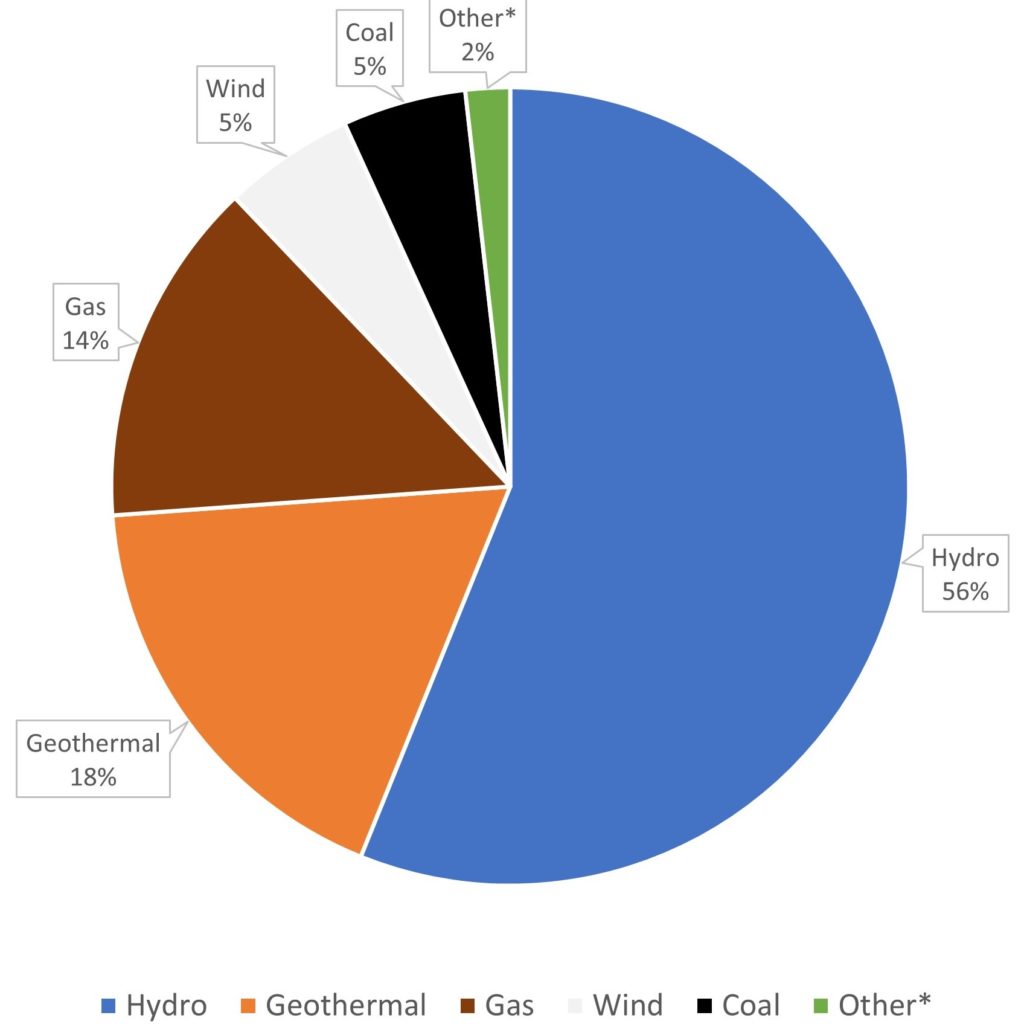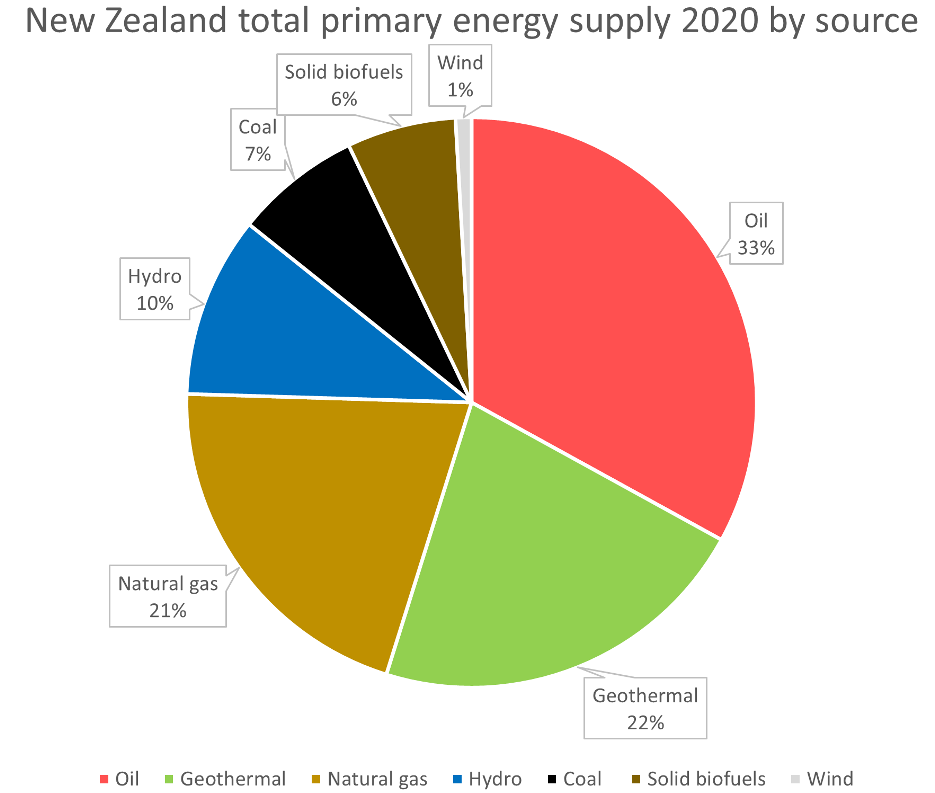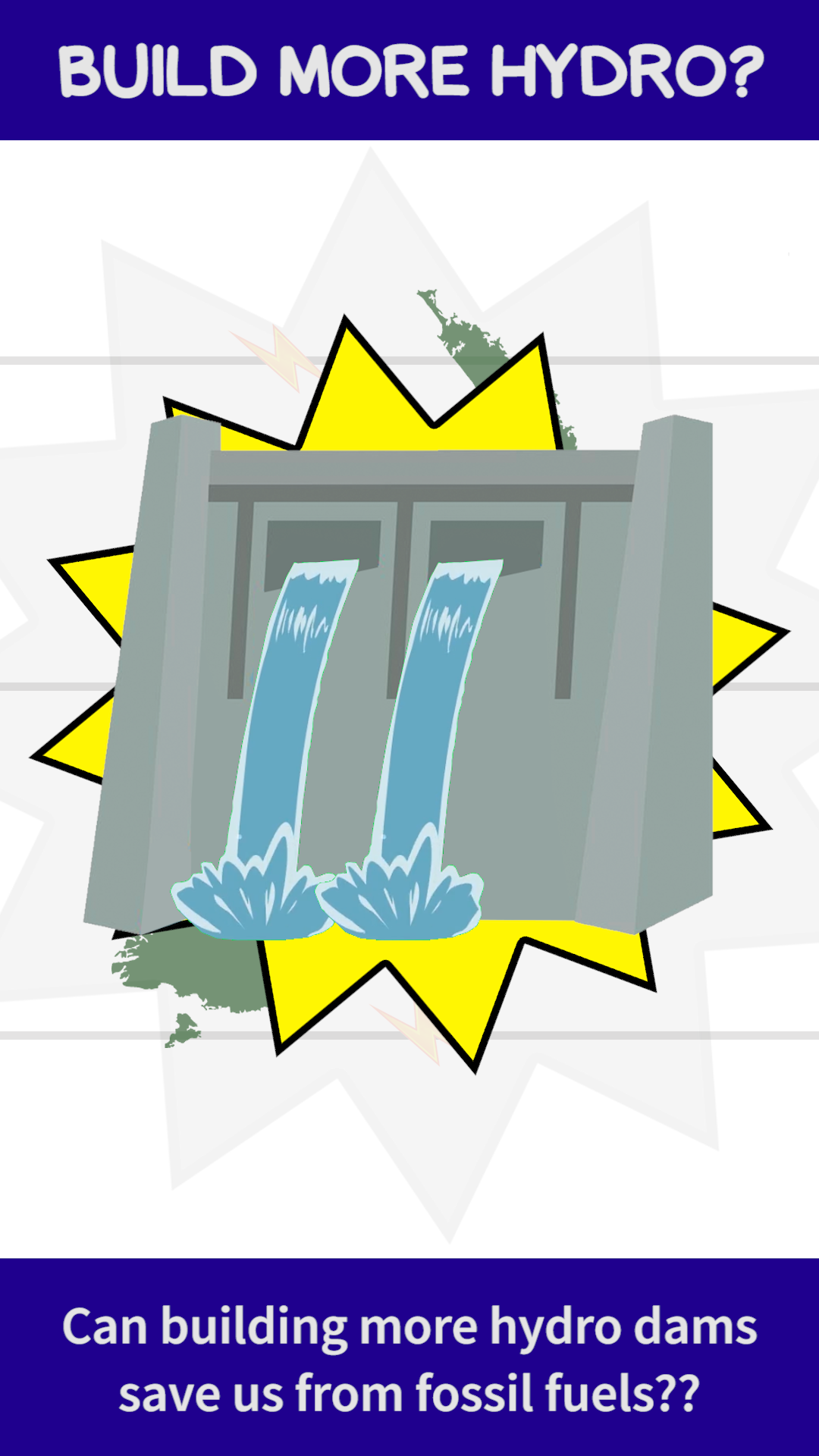New Zealand’s position as a world leader in renewable electricity generation hasn’t just fallen from the sky – it falls from the sky, runs down rivers, and spins turbines on its way back to sea level.
New Zealand electricity generation by source 2020

In 2020, New Zealand’s electricity was generated by hydro, geothermal, natural gas, wind, and coal. Small amounts came from other sources including: wood (1.06%); biogas (0.63%); oil (0.39%); solar (0.37%); waste heat (0.09%)[1].
Given how much hydro is already New Zealand’s largest source of electricity, it’s fair to ask just how much more hydro electricity the country would need to permanently put coal and gas on the back burner.
When was the last major hydro scheme built in New Zealand?
It’s been thirty years since the Clyde Dam was commissioned – the last significant addition to the country’s fleet of hydro schemes. The contract for building it was awarded in 1982, and the dam started generating in 1993.
In total the Clyde generates about 4.86% of New Zealand’s hydro electricity supply[2] – about a quarter of the amount generated by fossil fuels in 2020. This means, in a very rough sense, it would take about another four Clyde Dam sized hydro schemes to match and in turn replace coal and gas generated electricity[3], assuming of course demand growth were flat and output from all other sources remains constant.
The Clyde Dam, like many other hydro schemes in New Zealand, was controversial – so much so that the government of the day overrode a High Court ruling by passing an Act of Parliament – the Clutha Development (Clyde Dam) Empowering Act [4] – to make the scheme possible.
Have there been any attempts to build big since the Clyde Dam?
It’s been about a decade since anyone had a crack at a big hydro scheme in New Zealand. In 2012, Meridian Energy gave up on a proposal to build a dam on the Mokihinui River near Westport on the West Coast[5]. The dam would have been about a fifth the size of the Clyde Dam 1990[6] ,with about 85 MW capacity compared to the Clyde’s 464 MW capacity.
The scheme would have involved an 85 metre high wall, created a 14 kilometre long lake, obstructed the Mokihinui River, and flooded about 225 hectares of public conservation land[7].
Meridian Energy applied to the Buller District Council and the West Coast Regional Council for the appropriate resource consents. In total, the company applied for 34 consents[8] , which were granted under the Resource Management Act in April 2010[9].
Later in the same month, the Department of Conservation, which disagreed with the granting of the consents, appealed the decision to the Environment Court[10].
The Department of Conservation had opposed granting of consents during the consents hearing process, arguing the hydro dam, transmission lines, and other associated infrastructure would have significant effects on the river, forests, and threatened wildlife[11].
The Department of Conservation’s appeal was on the grounds it felt the concerns it had raised in the consents hearing process had not been adequately considered, leading to its decision to appeal the matter to the Environment Court[12] .
Obtaining resource consents was simply the first step in getting regulatory approval – of almost greater significance and difficulty was getting access to the required public conservation land through a concession from the Department of Conservation[13]. In May 2010, Meridian Energy informed the Department of Conservation it would be withdrawing its application for a concession, for land access, as well as an application for a proposed “land-swap”[14] arrangement.
The Environment Court hearing had been scheduled for September 2012, but before it could take place, Meridian Energy announced in May of the same year that it would longer be progressing the scheme, and withdrew from the Environment Court process[15].
At the time Meridian Energy, Genesis Energy, and Trustpower all expressed the view that the days of building large hydro schemes may be over[16].
What about smaller scale schemes?
A more recent attempt by a company to construct and operate a hydro scheme was when Westpower attempted to progress its development of a run-of-river hydro scheme on the Waitaha River, again on public conservation land on the West Coast. The scheme had an estimated output of about 120 gigawatt hours per annum – about 0.27% of New Zealand’s 2020 electricity generation[17].
An application for access to the Waitaha River, managed by the Department of Conservation, was rejected, due to the minister responsible deeming a decision to grant a concessions as ‘contrary to the provisions of the Conservation Act’ [18].
This decision was made even though the minister was satisfied any impact on birds, bats, lizards, invertebrates, native fish, other aquatic communities, sediment, and river morphology would all have been minor [19].
Of 84 identified potential small-scale hydro schemes in New Zealand, almost half (37) are on public conservation land [20].
What if New Zealand just built every potential scheme everywhere? How much more electricity could the country generate?
New Zealand’s operating hydro electricity schemes have a combined capacity of 5,434 MW[21] and generate close to 60%[22] of the country’s electricity supply.
In 2020, the Ministry of Business, Innovation, and Employment commissioned a report on New Zealand’s potential hydro electricity resources. The report (authored by Roaring 40s Windpower Ltd on behalf of the government) identified large scale hydro potential of 2,043 MW[23], and another report on small scale schemes identified 236 MW of capacity[24] – a total of 2,279 MW, which would grow New Zealand’s hydro capacity by about 44.5%[25] if built.
Such an increase in hydro capacity would potentially increase New Zealand’s total electricity generation by close to 25%, eclipsing the current 19% of New Zealand’s electricity generation currently sourced from coal and natural gas – but only assuming all the potential schemes could be financed, consented, and built. The average construction time frame for construction of a large scale hydro schemes in New Zealand is about eight years.
The difference between electricity and energy
New Zealand’s electricity supply is only part of the wider energy sector, which includes all the oil based transport fuels, the coal and natural gas used in the country’s industrial sector as a direct source of energy, as well as renewable sources like geothermal and wood based fuels. In total about 61% of the country’s energy supply is made up of fossil fuels[26].
In the highly unlikely outcome of hydro supply increasing by 40% or even 50%, the total energy supply would only increase about 4%-5%[27]. Again, this would require every conceivable scheme to be constructed, which is very unlikely.

This would, perhaps, get within punching distance of the 7% of New Zealand’s energy supplied by coal[28], but not for the 21%[29] supplied by natural gas, or 33% of energy supplied by oil[30].
Conclusion
It’s very likely if New Zealand’s number of hydro schemes increased, consumption of fossil fuels would reduce, especially in the electricity sector. What’s highly uncertain is what number, if any, of the identified potential hydro schemes in New Zealand will ever be built.
Even if all that building were to start tomorrow, given it would likely take eight years just to build one major dam, coal and natural gas would certainly have a role to play in the intervening years to build the dam things.
References
If you’d like to check any of the facts or resources that informed this article, please check the full list of references by clicking here.
